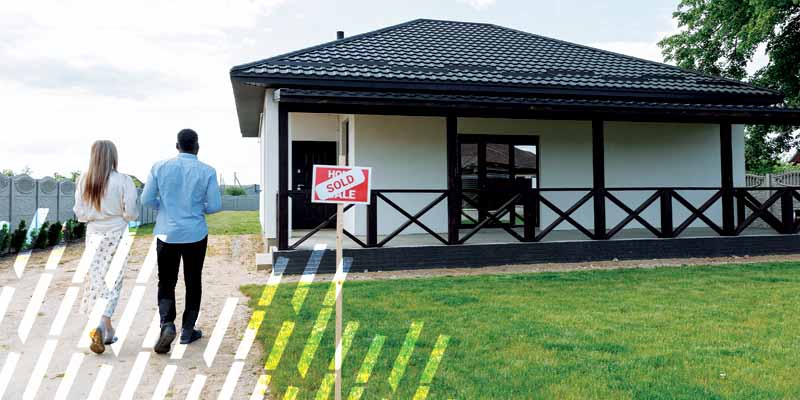Posted On: May 17, 2024 by Prevail Bank in: Home Loans

2024 home ownership unachievable? Prepare with these 8 tips.
Are the high home prices and interest rates kiboshing your plans of home ownership? It doesn’t have to be hopeless. Follow these tips so when the right house, the ‘affordable’ house, is available, you can confidently make an offer.
If you’d describe the home buying landscape as terrible or nightmarish, you wouldn’t be alone. A PBS News Hour article (March 2024) says the U.S. housing market is in a crisis. The ability to purchase a home is nearly impossible, especially for first-time homebuyers.
What is a Housing Affordability Crisis?
The US Department of Housing and Urban Development (HUD) defines home affordability as a home that costs a household (the owner) no more than 30% of a his/her annual income. A housing affordability crisis occurs when the money needed to afford a typical home is more than what a typical household earns.
We are in just such a circumstance. According to CNBC.com a would-be homebuyer (household) would need to earn $113,520 a year to afford the typical American home. Unfortunately, the typical US household is only making $84,072. Housing costs are increasing more quickly than incomes.
There are 5 reasons contributing to the housing affordability crisis.
- America didn’t build enough homes for its growing population. The demand for homes exceeds supply. And when this happens, Economics 101 tells us: When demand is high and supply is low, prices go up. And up they did go!
For homes in Wisconsin, using Zillow data from February 2024, The Forbes Advisor team calculated that a single-family home’s typical value 5 years ago (both new & preexisting in the 35th-65th percentile range) was $202,016; that same home (in April 2024) is now valued at $298,247!
- Average mortgage rates have more than doubled. Four years ago, the 30-year fixed rate for a mortgage was just under 3%. Today, it’s between 6.8% and 7.09%. It may not sound like much, but it makes a BIG difference.
Hypothetical example: If you could afford an $1,800/month mortgage payment of principle and interest, a home affordability calculator (based on a fixed, monthly budget*) will tell you you can afford a house up to $388,500, IF the 30-year fixed loan rate was 3% at the time (and everything else is zero). But, if the interest rate is 7%, the amount you could afford drops to about $254,600. The interest rate alters what you can comfortably afford.
If you click on the link provided in this paragraph, scroll to the center of that page to find the affordability calculator based on a fixed budget.
So, based on the example just shared, homeowners who have a ‘low’ mortgage rate aren’t interested in selling and purchasing something else. If they did, the likelihood is very high they would be paying the same monthly mortgage amount, or more, for far less house than they have today due to the higher interest rate. - Consumer price inflation is another reason why the US is in a housing affordability crisis. Routine expenses rose 19.6% between January 2020 and January 2024; which means, more of your paycheck is being spent on utilities, food, gas … than it was in the past, making it difficult to save money for that 10-20% down payment needed to purchase a home.
- The cost to rent is equal to or more than a mortgage payment in many places, which again hinders a person’s ability to save for a future down payment.
- And finally, new energy codes are now required for all HUD- and USDA-financed single-family homes being built. While this may sound good, studies show that building to these new codes can add up to $31,000 to the price of a new home and may take up to 90 years for a home buyer to realize a payback.
A quick fix to the crisis is not on the horizon. No one is forecasting a return to 3% rates anytime soon. So, until supply catches up with demand, prices are unlikely to fall. But take heart, change for the better is transpiring, but at a very slow pace.
You can still prepare yourself to be a homeowner. Here’s what you should do. Prepare with these 8 tips.
- It is crucial that you get your finances together.
- Shop around for mortgage lenders.
- Look for first-time homebuyer grants and programs.
- Get prequalified for a loan.
- Find a buyer's real estate agent.
- Create a list of home must-haves & nice-to-haves.
- Determine which neighborhoods you want to target.
- Shop around.
1. It is crucial that you get your finances together.
- The first step is to determine how much house you can afford. A Home Affordability Calculator can be helpful in this respect. This is different from a mortgage calculator. A mortgage calculator will tell you what your approximate mortgage payment might be, not what you can afford.
It’s important not to buy a home that becomes a financial burden. Ideally, you want your monthly mortgage payment to be NO MORE than 30% of your monthly take-home (after tax) pay; some advisors recommend 25%, others 28%.
- Now that you know how much house you can afford, use a Mortgage Calculator to compute an approximate monthly mortgage payment. Mortgage calculators allow you to change the factors of your potential loan, IE: the down payment amount, loan length, and interest rate. It’s an eye-opener! Use it to identify what you need as a down payment that results in a monthly payment that you can afford.
A monthly mortgage payment should include a principle amount, interest, property taxes, home insurance, PMI, and HOA fees.Are you saving enough? Can you afford to refinance your home? Will your children have enough money to pay for college? Prevail Bank's financial calculators can help you get a better sense of what the future holds for your finances.
PMI is Private Mortgage Insurance that protects the lender (not you) if you happen to default on your payments. You will most likely be required to buy it if you take out a conventional loan with a down payment that is less than 20% of your home’s purchase price. Because PMI increases your monthly payment, most folks do their darndest to put down 20%.
A Homeowners Association (HOA) is an organization that makes and enforces rules and guidelines for a subdivision, planned community, or condominium building. Those who buy property within an HOA’s jurisdiction automatically become members and are required to pay dues – aka HOA fees (which will be a separate monthly or quarterly payment in addition to your mortgage). HOAs in Wisconsin are not as prevalent as they are in other states. Only 12.7% of Wisconsin’s population lives in an HOA.
- As alluded to above, a cash down payment is typically required when you officially purchase a home. The targeted down payment amount is typically 20% of the home’s purchase price, because a PMI expense is not required then (usually).
- A down payment isn’t the only cash you’ll need when you close on a home. Anticipate loan closing costs (an appraisal fee, home inspection fees, loan origination fees, credit report fees, possible attorney fees, home insurance, and your portion of the property taxes). On average, these closing costs are 3-4% of your home’s purchase price.
- Lenders also want to know that you’ll have some money left over after you make your down payment and closing costs. It doesn’t have to be a huge amount but showing that you have a little something left over is good. CNBC says a person should budget / plan to spend an additional 1%-3% of your home’s value, every year, to cover maintenance expenses. So, if your home is $254,600, the minimum you’ll want to have handy is $2,506 in a separate savings account. Use this as the cash cushion that lenders are looking for.
Add the dollars identified from points 1C through 1E together. This is the typical expectation; this is what you need – in cash – prior to becoming a homeowner. Start saving!
20% down payment +4% closing costs +1% maintenance cushion = 25%
25% of a home priced at $254,600 = $63,650.
- Getting your finances together also includes paying off as much debt as you can, in addition to increasing your credit score. Financial institutions aren’t comfortable lending their money to individuals who struggle to pay their bills. It’s usually an indicator that you’re already too deep in debt to be incurring more. Pay off your small debts and work your way to the bigger ones.
Conventional loan lenders typically want you to have a credit score of at least 620. The higher your score, the better. Paying off debt is one possible way to increase your credit score. Other ways to do so include:- Avoid missed payments / Avoid past due payments.
- Don’t max out your credit cards.
- Stay below your credit limit.
The key to saving money and paying off debt is making and sticking to a detailed monthly budget. Do some quick research; Google “Best Budgeting Apps” and pick a free resource to get you started. Remember, the best budgeting tool is the one you’ll actually use; keep this in mind. You need to use it and stick to it, if you want to get ahead.
Prevail Bank offers its customers Credit Sense, a free credit score monitoring service that offers help and tips to improve a person’s credit score, a financial assessment and budget breakdown analysis that provides personalized suggestions for improvements so you can achieve your home buying goal, plus other financial tools.
Prevail Bank’s website has a ‘Banking’ blog category that includes numerous articles relating to: How to improve your financial health, increasing your credit score, and how to save money - automatically. Check them out.
Besides getting your finances together (as if that isn’t enough), what else can you do in preparation to buy a home?
When you’re making headway relating to your financial situation, your employment is steady and secure, and you expect to be in one location for at least the next five years:
2. Shop around for mortgage lenders.
Look for the best mortgage rates and favorable fees.
Prevail Bank has experienced home loan originators (mortgage lenders). They are solution seekers for those who want to be home owners.
When you use Prevail Bank’s home loan rate calculator (after you type in the home’s purchase price, a down payment amount, and credit score) you will receive an approximate closing fee total and an estimated monthly mortgage payment based on the current interest rate at Prevail Bank. (NOTE: Interest rates do have the ability to change without notice. But, if you like what you see after clicking ‘Get Rates’ there is an option to APPLY NOW (online) through Prevail Bank’s website.
3. Look for first-time homebuyer grants and programs.
There are special grants and loan programs out there for first-time homebuyers, homes in rural areas, for veterans, and fixer-uppers. Wisconsin Housing and Economic Development Authority may have homebuying programs to consider as well. These programs are tailored to help buyers with limited resources and/or those with less than perfect credit scores.
Be aware, all of the special grants and loan programs you’ll read about are not offered by all of the financial institutions out there. That’s because each program requires a special relationship with another vendor who can process all the detailed requirements that come with it. When you’re shopping around for a mortgage lender, this would be something to inquire about, especially if you think you might qualify for one of them.
Prevail Bank can not offer you all of the homebuyer grants and programs out there, but it is worthy of consideration based on its competitiveness, personal commitment to finding a solution, and one-on-one assistance. Contact a Prevail Bank home loan originator for a personal consultation and more information.
4. Get pre-qualified for a loan.
Pre-qualification is an estimate of how much a lender may loan you based on factors like credit history and income. Usually this can be done over the phone or online and is often free. The lender may also look at your credit report for additional information to help better understand your current credit situation and loan-paying history. Pre-qualification is NOT a loan guarantee, it just gives you a general idea of the home price you can start looking at.
5. Find a buyer’s real estate agent.
Interview a handful of agents. You want someone who fits your personality, communication style, specializes in the neighborhoods you’re interested in, and one who will help educate you. The agent’s name that is shown on the ‘for sale’ sign or as the ‘listing agent’ in a home’s online profile is NOT the person you want to have as your agent (especially if you’re interested in those homes), because they represent the seller. The seller would be their first priority, not you.
6. Create a list of home must-haves & nice-to-haves.
Remember to be flexible about home size and location. Some must-haves, IE: hardwood floors, can be added later as a home improvement. Discuss this list with your agent.
7. Determine which neighborhoods you want to target.
Share with your agent what you can afford – and stick to it. Ask your real estate agent about previous home sales in the area, neighborhood market trends, nearby amenities, and schools. Ask if any neighborhoods just outside your circle may be a worthwhile consideration based on what you can afford. A slightly longer commute may be worthwhile for a less expensive, but nicer home.
8. Shop around.
Take tours of homes, physically and/or virtually, and stay within what you can afford. When you’re ready to make an offer, your agent will manage all the paperwork and any negotiating relating to counteroffers. Follow their lead and recommendations.
What if you can’t afford your housing market?
It is frustrating when the dream of home ownership is yours, but the home prices in your targeted neighborhood are just too high for your pocketbook. What should you do then?
- Consider a different neighborhood. You may not have to move very far (perhaps an hour from a metropolitan area) to see a major change in the cost of homes. Could the longer commute be worth it?
- Increase your income: consider another job, a side hustle, or a new job that pays more.
- Review your ‘must have’ list. It is unlikely you’ll be living in this home forever. Research indicates the average person will own at least three homes in their lifetime. So, let go of the outdoor pool, hardwood floors, and luxury kitchen; be flexible. (Keep in mind, these extras could be added at a later date as a home improvement project.)
- Be patient and diligent. Keep saving money. It may take awhile to save what you need (for a down payment, closing costs, the first year’s annual maintenance expense) --- That’s okay! Because if you don’t and you buy a house you can’t afford, it will put you on the fast track to going broke. Ramsey Solutions strongly advocates sticking to the 25% rule. Which means, keep your monthly mortgage payment to no more than 25% of your take-home pay and “You’ll be golden.” Just because you qualify for more money doesn’t mean you can afford it.
For more information relating to home ownership, home loans, and mortgage tips, review the articles posted under Prevail Bank’s “Home Loans” blog category, or speak to any one of Prevail Bank’s home loan originators.
Prevail Bank offers home construction loans, land purchase loans, home improvement, home refinance, and home purchase loans (adjustable rate, and short/long-term fixed rate mortgages).




